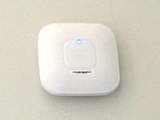Massive summer project makes things faster, better
If you’ve been using the UMBC campus wireless system lately (and our administrative software says that you have), you may have noticed a big improvement in speed and coverage. That’s because this summer, DoIT’s network engineers completed, in record time, a comprehensive system upgrade that brings UMBC up to current 802.11 standards.
That’s not to say that the campus wireless network has been ignored until now. Far from it. But the piecemeal ways in which previous expansions to the network were done, with an eye toward basic functionality that provided coverage to about 90% of building interiors, left UMBC with a hodgepodge of technologies, some almost 10 years old.
Discussions about a possible upgrade began in April. Soon after, the Office of Residential Life, eager to improve the wireless network in its buildings, agreed to fund upgrades to all of the residence halls. After the university put forward the funding for the academic buildings, the project was approved.
The massive amount of new network equipment required for the upgrade was ordered in May and arrived in June, when work commenced in the residence halls.
In Chesapeake Hall, for example, owing to the building’s solid cinder block construction, wireless signals were often interrupted. To combat this, during the building’s renovation, access points were installed in every other room, giving each group of four suitemates a point of their own.
Another immediate problem was in locating all of the 900 existing access points, many of which weren’t mapped. This was done with detection software, and a fair bit of eyeballing. Within two weeks, over 500 access points in the residence halls had been upgraded. Each access point would require approximately 30-45 minutes of work from two student employees to complete, with the project ultimately requiring over 1500 total hours of work.
Six student employees, along with network engineers Carlos McKinney and Ray Soellner, did the lion’s share of the work. The project also received an assist from DoIT’s telecom group with helped with some tricky wiring issues, and some of the more problematic locations.
Once the student staff had done the hands-on work, they assisted the network engineers to complete the configuration tasks, including making sure to accurately map the locations for each of the now 1200 access points.
In mid-July, work on the main campus began, which presented some unique challenges, such as the access point located in the rafters above center court in the RAC, and the one 20’ from the floor in Public Policy’s Lecture Hall 9.
Network Engineer Carlos McKinney remembers Lecture Hall 9 well.
"What we ended up having to do,” McKinney said, “is calling somebody from the electric shop to get an extension ladder to get to this one access point at the top of the lecture hall.”
McKinney said, “It did more swaying from side to side than I would expect an extension ladder to do, especially when you're trying to climb it. Ultimately we were able to get the access point replaced, but that was a bit of a trial, especially for me. I generally don't like heights anyway, and now I'm climbing up this extension ladder that's swaying, and it's not like I can grab onto something - it's a sheer wall.
“So, that was fun. But ultimately we got the access point replaced, it came up and everyone was happy."
In the Commons, where up to 1100 wireless devices might be in use at any given time, the number of access points was increased from 22 to 46, and these were placed closer to the places where traffic was heaviest.
Damian Doyle, DoIT’s Assistant Director of Networks and Security, commented on the changes there.
“Last semester in Commons, if you sat in Main Street in the middle of the day and tried to use wireless, you could barely check your email. You could maybe get a third of a megabit through, it was just so saturated with people,” Doyle said.
“I went over yesterday and did some informal measurements and I was getting fifteen or twenty megabits down to my phone,” said Doyle.
Work on the project was completed on August 21, with only days to spare before the fall semester was to begin. Similar projects at College Park and Towson took 6-12 months, while employing outside contractors, which greatly adds to the costs.
Now that the upgrade is completed, wireless users should notice a number of immediate benefits.
Doyle said, “[Before the upgrade] I could stream YouTube or run basic services; if I tried to do a bandwidth calculation I could maybe get 10 megabits. Now, I get sixty or seventy.
“Users will now see a lot less buffering. They’ll be able to multitask. If they are going to do higher end computing, if they’re really pulling a lot of data down, it’s probably an order of magnitude different, maybe five or ten times faster,” Doyle said.
With this massive improvement behind us, DoIT is already looking ahead to the next generation of wireless infrastructure, which is up to 10X faster than current standards. That means that a repeat performance of this summer’s magic will likely be required in the next three to five years.
Let’s just hope that the same great team of engineers and technicians is involved in that project.
Posted: September 5, 2013, 9:22 AM
